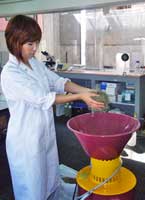Web Japan > Trends in Japan > Sci-tech > Biofuels from Nonfood Sources
Biofuels from Nonfood Sources
Combating Global Warming Without Impacting Food Supplies
In the global effort to reduce greenhouse gas emissions, many are hoping that biofuels can be a part of the solution. Biofuels offer the benefit of being "carbon neutral," because the carbon dioxide released when the fuels are burned is balanced by the CO2 they absorb from the atmosphere as they grow. Bioethanol produced from crops like corn and sugar cane is currently the main biofuel. The problem is that these are food crops, so using them for biofuel risks reducing food stocks and pushing up food prices. To address this problem, researchers all over Japan are working to develop biofuel made from nonfood plant sources and the inedible parts of food crops.
Biofuel from Waste
Rice is a staple food for the Japanese people and is cultivated in rice fields in every region of the country. In the course of harvesting this rice, a large volume of rice straw must be reaped, most of which is incinerated. Finding a way to process this straw into biofuel would turn it into a valuable resource, but this task involves several difficulties. One is that reaped straw is bulky, which makes it costly to collect and transport. In addition, rice straw is composed of cellulose, which is hard to break down and process into biofuel. To overcome these challenges, in 2008 the Ministry of Agriculture, Forestry, and Fisheries began tackling the issue of expanding production of Japanese-style biofuels.

Students of Gifu University who are researching the production of biofuel from golf course grass clippings. (Photo courtesy of Professor Takamizawa Kazuhiro, Gifu University)
The ministry is providing funding for projects that seek to derive biofuel from nonfood plant materials, such as rice and wheat straw. Two projects have been selected to receive funding in the fiscal year 2008 (April 2008 to March 2009). One is being carried out in Hokkaido by Taisei Corporation and Sapporo Breweries Limited; the other is based in Hyogo Prefecture and is administered by Mitsubishi Heavy Industries and the Hyogo Environmental Advancement Association. In addition to herbaceous plants, the ministry is also pursuing ways to produce biofuel from wood materials, such as timber culled during forest thinning. The goal is to use these materials to produce 6 million kiloliters of biofuel per year in Japan by 2030.
Innovative Techniques Hold Promise
Meanwhile, the Hokkaido Industrial Research Institute is focusing its efforts on stems, husks, and leaves from corn plants. While bioethanol is already being produced from the corn itself, production efficiency will increase significantly if the cellulose-based parts of the plant can also undergo processing. To that end, the institute is seeking a means of accelerating the breakdown of cellulose by conducting research into enzymes and experimenting with physical processes like pulverization and the application of heat. The head of this research project notes, “If we are successful with corn by-products, it’s possible for us to apply the same process to rice straw and other herbaceous forms of biomass.”
There is also a project underway to create biofuel from the grass grown on golf courses. Professor Takamizawa Kazuhiro and other researchers at Gifu University have developed a technique for speeding up the breakdown of cellulose by combining two different types of enzymes; application of this process allows for ethanol to be produced more efficiently from grass cuttings than from sugar cane. It is estimated that one year of cuttings from an 18-hole golf course could provide sufficient quantity of ethanol to power two automobiles for a year. Since a single golf course spends millions of yen each year to dispose of grass clippings, this ingenious plan has the potential to solve both problems at once and is already drawing interest from the golf industry. (December 2008)



